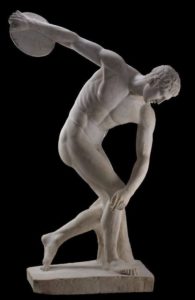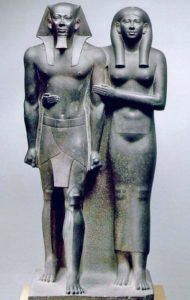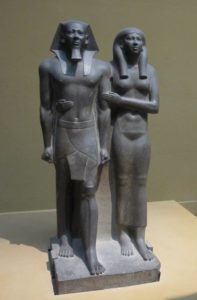In the ancient world there were many civilizations and each and every one had their own ideologies in art. Mesopotamian art mostly consisted mythological creatures or realistic depictions of people. While Egyptian art illustrates the deities of the Egyptians. As well, the Greeks portray their mythological creatures; however, they mostly portrayed their nude athletic bodies. The Romans produced art involving real people especially their emperors. Every civilization had their own depictions of art which poses some similarities and some differences.
First off, Egyptian and Mesopotamian art are similar due to both of these civilizations thriving in close time periods. The architecture of both cultures is humongous. The layout of their paintings is also similar with most body parts including the heads, hands, and feet were facing towards the side but the torsos are shown facing towards the viewer. Another similarity between the two cultures is that they were polytheistic and their art depicted all of their gods.
Also, Greek art is tied with Roman art due to the Greek Empire existing before and during the Roman Empire. As well, the Romans loved Greek culture and would replicate many of their pieces and would learn from the Greeks and use their techniques in creating their own art. They both depict mythological creatures in their art. During the Hellenistic era of Greek art there was a boost of naturalistic art which the Romans used throughout their empire. Both cultures used white marble to create some of their sculptures.
But, all four have several things in common. All of the mentioned civilizations spent long times making sculptures which are detailed to the smallest points. They depict mythological beings with unearthly body parts doing unbelievable things. They’ve created large monuments and buildings who were dedicated to their gods in some way (I know pyramids were made for the resting place for royalty but the Egyptians believed they were gods).
However, each culture has their own characteristics in their choice of art. All of the cultures used different materials from mud brick to sandstone and from marble to bronze. They all depicted their own mythological creatures/deities, some would be standing, guarding, or/and judging while others would be doing things like handing things out, helping people, or/and hurting people for doing something wrong.
The Romans built on Greek art and arguably made it more modern. Even though both civilizations made similar structures in the Pantheon which the Greek built to honor the god Athena, the Romans built the Pantheon to honor all of the Roman gods. The Greeks would show off their nude and athletic bodies but after the Roman saw this, they believed covering themselves up was better due to being unproper. As well, the Romans depicts regular people unlike the Greeks.
Both the Mesopotamian and Egyptians designed their art in different ways. The Mesopotamians created ziggurats, temple in which they served their gods which were created by sun dried mud-blocks, which made them less resistant to erosion. However, the Egyptians created pyramids to bury their royalty which were built with sandstone, which makes it very resilient and why we are able to see them today. There were Mesopotamian painting that depicted regular people. Unlike the Egyptians who mainly focused on their gods and goddesses in their paintings. The further time goes, the more art changes and morphs and even though this happens, there will always be some staple to what art truly is.
















